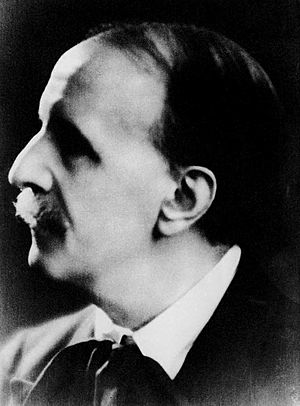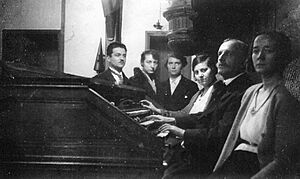Louis Vierne facts for kids
Quick facts for kids
Louis Vierne
|
|
|---|---|

Vierne c. 1910
|
|
| Born |
Louis Victor Jules Vierne
8 October 1870 Poitiers, France
|
| Died | 2 June 1937 (aged 66) Paris, France
|
| Education | Paris Conservatory (1894-1911) Schola Cantorum (1911-1935) École César Franck (1935-1937) |
| Occupation |
|
| Years active | 1892–1937 |
|
Works
|
List of compositions |
| Relatives | Charles Colin, René Vierne |
| Signature | |
 |
|
Louis Vierne (born October 8, 1870 – died June 2, 1937) was a famous French organist and composer. He was the main organist at Notre-Dame de Paris from 1900 until he passed away. Vierne mostly wrote music for the organ. This included six large pieces called organ symphonies. He also wrote a special mass for choir and two organs. He traveled across Europe and the United States to perform concerts. Many well-known musicians, like Nadia Boulanger and Maurice Duruflé, were his students.
Early Life and Education
Louis Vierne was born in Poitiers, France, on October 8, 1870. His father, Henri-Alfred Vierne, was a teacher who later became a journalist. Louis was born with very poor eyesight due to a condition called congenital cataracts.
Even at a young age, Louis showed an amazing talent for music. When he was only two, he heard a lullaby played on the piano. After it finished, he was able to play the notes of the song himself on the piano.
His family moved to Paris when he was three. At age six, Louis had eye surgery. This helped him see shapes and people better, and he could read large letters. He started taking piano lessons in Lille. His teacher wrote music on very large music sheets for him. He also learned to read music in Braille.
In 1880, his family returned to Paris. Louis studied piano with Louis Specht, a blind teacher. In 1881, Louis was accepted into the National Institute for the Young Blind. His teacher, César Franck, suggested he study the organ. Louis began organ lessons and also studied music theory with Franck.
He joined the Paris Conservatoire in 1890. After Franck died, Charles-Marie Widor became his new teacher. Louis became Widor's assistant in the organ class. He also helped Widor as an organist at the Saint-Sulpice church. In 1894, Louis won the top prize in the organ class at the Conservatoire. He continued to assist Widor and later Alexandre Guilmant.
Career at Notre-Dame
On May 21, 1900, Louis Vierne won a competition to become the main organist at Notre-Dame de Paris. This was a very important job in France. He held this position until he died in 1937.
The organ at Notre-Dame was often in need of repairs during his time there. To raise money for its restoration, he went on a concert tour in North America. He played famous organs in cities like Philadelphia and New York City. The tour was very successful, but it was also very tiring for him.
In 1906, Louis had a street accident in Paris. He badly broke his leg. For a short time, doctors thought his leg might need to be removed. Luckily, his leg was saved, but it took him six months to recover. He had to completely re-learn how to use the organ's foot pedals.
Teaching and Later Life
Louis Vierne taught at the Conservatoire for 19 years. Many of his students became famous musicians themselves. Some of his well-known students included Joseph Bonnet, Nadia Boulanger, and Marcel Dupré. He was a kind, patient, and encouraging teacher.
In 1912, he also began teaching at the Schola Cantorum. During World War I, Louis went to Switzerland for eye treatment. He expected to be away for only a few months, but due to problems, he stayed for four years. His brother, René, died during the war. Louis wrote music to remember him.
Louis returned to Paris in 1920. He continued to tour and perform in many countries. He visited Switzerland, Italy, Germany, England, and Scotland. In 1927, he went on another three-month tour of the United States. In 1931, the French government honored him by making him a Chevalier de la Legion d'honneur. This is a very high award in France.
Death
On June 2, 1937, Louis Vierne was giving his 1,750th organ concert at Notre-Dame. He finished the main part of the concert, and people said he played as well as ever. He was about to play two improvisations, which means making up music on the spot.
He read the first musical idea in Braille. As he was choosing the sounds for the organ, he suddenly fell forward. His foot hit a low pedal note, and he lost consciousness. The single organ note echoed through the church. Louis Vierne had always said he wanted to die while playing the great organ of Notre-Dame, and his wish came true. Maurice Duruflé, another important French organist, was by his side.
Music
Louis Vierne had a very elegant and clear style of writing music. He always made sure his music had a good structure. His harmonies were rich and romantic, but not overly dramatic. Like other great French organists of his time, Vierne wrote music that perfectly suited the organ. His works have inspired many organist-composers who came after him.
His most famous works for organ include his six organ symphonies. He also wrote 24 Fantasy Pieces, which includes the well-known Carillon de Westminster. Another important collection is Vingt-quatre pièces en style libre.
Besides organ music, he also wrote chamber music. This includes pieces for violin and cello, a piano quintet, and a string quartet. He also composed vocal music, choral music, and a Symphony in A minor for a full orchestra.
See also
 In Spanish: Louis Vierne para niños
In Spanish: Louis Vierne para niños


